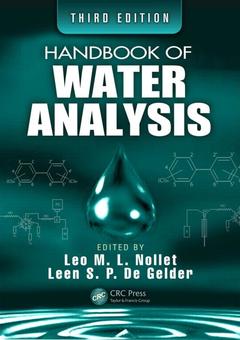Handbook of Water Analysis (3rd Ed.)
Coordonnateurs : Nollet Leo M.L., De Gelder Leen S. P.

Extensively revised and updated, Handbook of Water Analysis, Third Edition provides current analytical techniques for detecting various compounds in water samples. Maintaining the detailed and accessible style of the previous editions, this third edition demonstrates water sampling and preservation methods by enumerating different ways to measure chemical and radiological characteristics. It gives step-by-step descriptions of separation, residue determination, and clean-up techniques.
See What?s New in the Second Edition:
- Includes five new chapters covering ammonia, nitrates, nitrites, and petroleum hydrocarbons, as well as organoleptical and algal analysis methodology
- Compares older methods still frequently used with recently developed protocols, and examines future trends
- Features a new section regarding organoleptical analysis of water acknowledging that ultimately the consumers of drinking water have the final vote over its quality with respect to odor, flavor, and color
The book covers the physical, chemical, and other relevant properties of various substances found in water. It then describes the sampling, cleanup, extraction, and derivatization procedures, and concludes with detection methods. Illustrated with procedure flow charts and schematics, the text includes numerous tables categorizing methods according to type of component, origin of the water sample, parameters and procedures used, and application range.
With contributions from international experts, the book guides you through the entire scientific investigation starting with a sampling strategy designed to capture the real-world situation as closely as possible, and ending with an adequate chemometrical and statistical treatment of the acquired data. By organizing data into more than 300 tables, graphs, and charts, and supplementing the text with equations and illustrations, the editors distill a wealth of knowledge into a single accessible reference.
Sampling and Data Treatment Methods. Radioanalytical Analysis. Organoleptical Analysis. Analysis of Biological Parameters. Halogens, N-Compounds, and Phosphates. Cyanides, Asbestos, Metals, and Si-Compounds. Organic Parameters. Phenolic and Humic Compounds. Residues of Pesticides. Residues of PCBs, PCDDs, PCDFS, and PAHs. Surfactants and Petroleum Hydrocarbon Analysis. EDCs and Residues of Plastics.
Date de parution : 08-2013
17.8x25.4 cm
Thèmes de Handbook of Water Analysis :
Mots-clés :
Sample Preparation; SPME; Water; Te Ch; Chromatography; RSD; Chemical analysis; Water Samples; LPME; residues; Seawater; Tr Od; HTC Method; Ammonium Ions; Legal EU Limit; SIA; Sea Water; Ox Id; Tr Op; EPA Method; Ri Nk; Ow Injection; Mobile Phase; Natural Water Samples; Pulsed Amperometric Detection; IC; Inductively Coupled Plasma Mass Spectrometry; Asbestos Bers; OA



